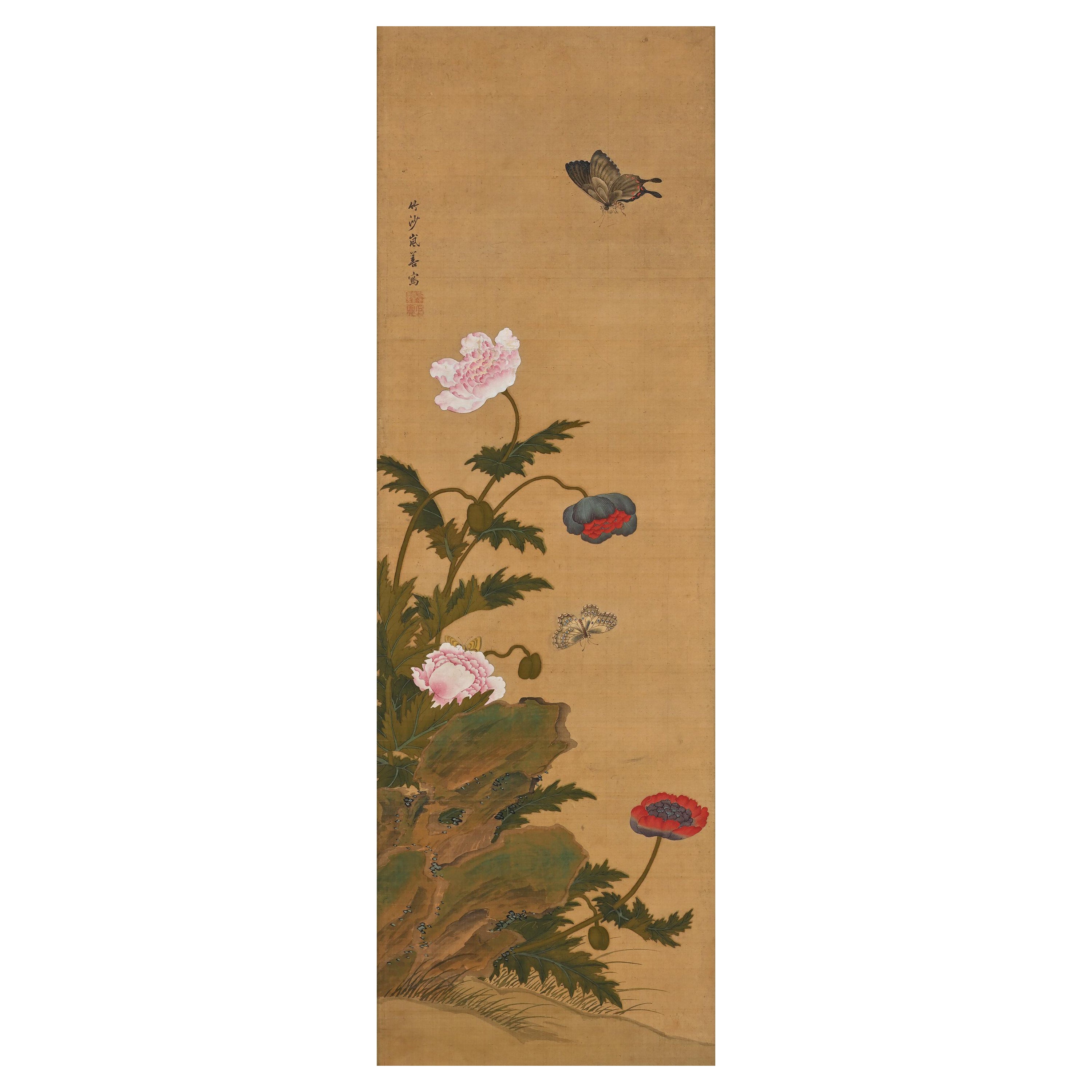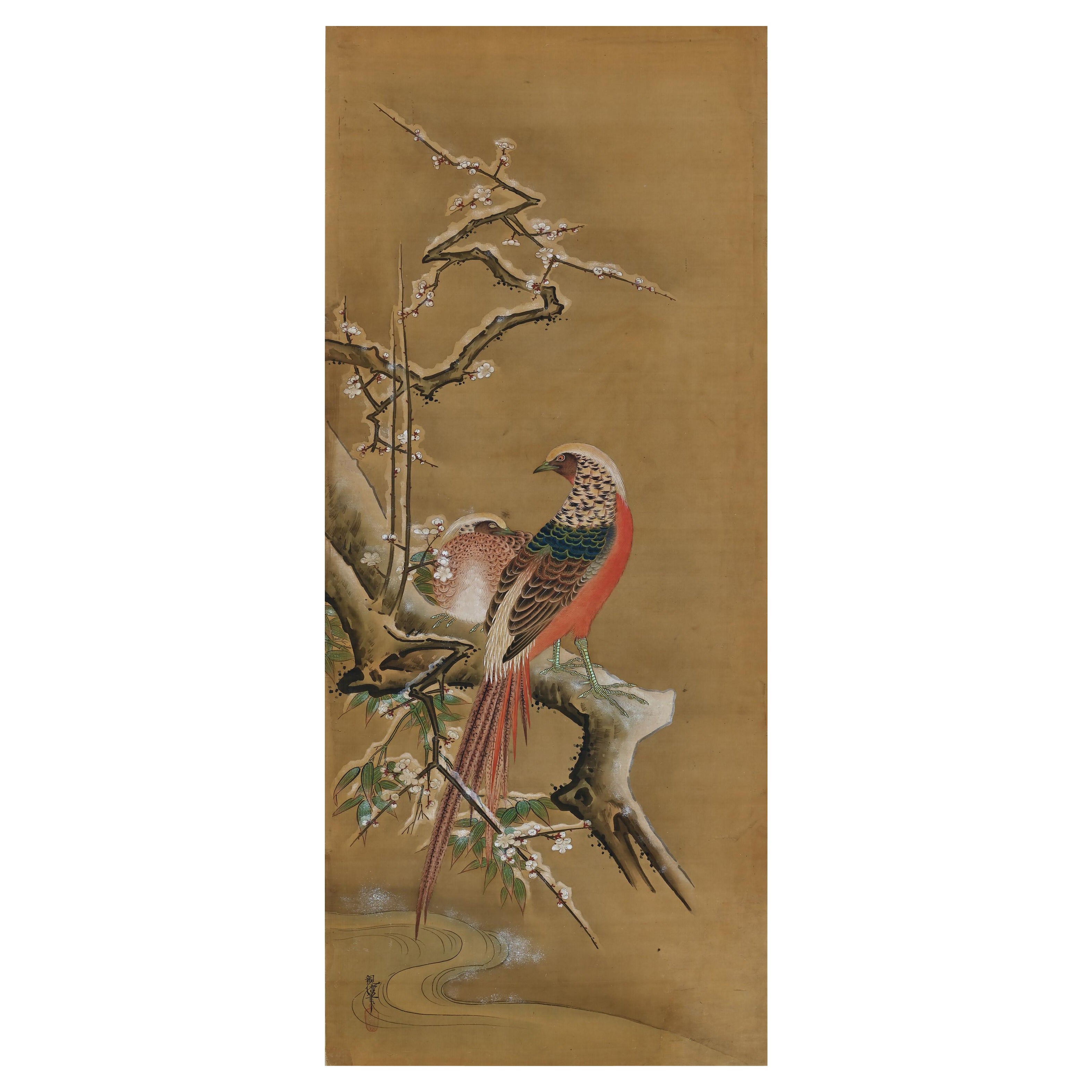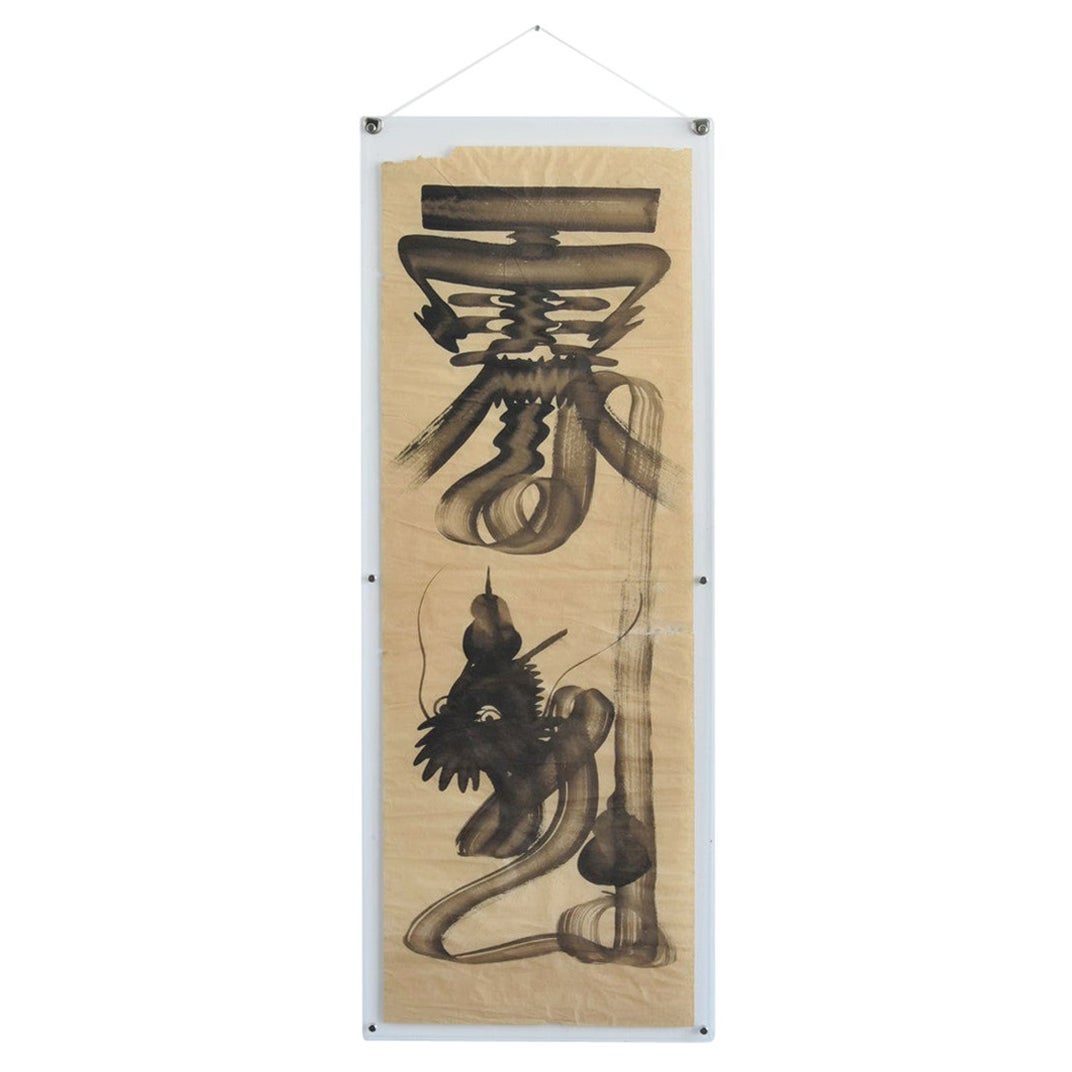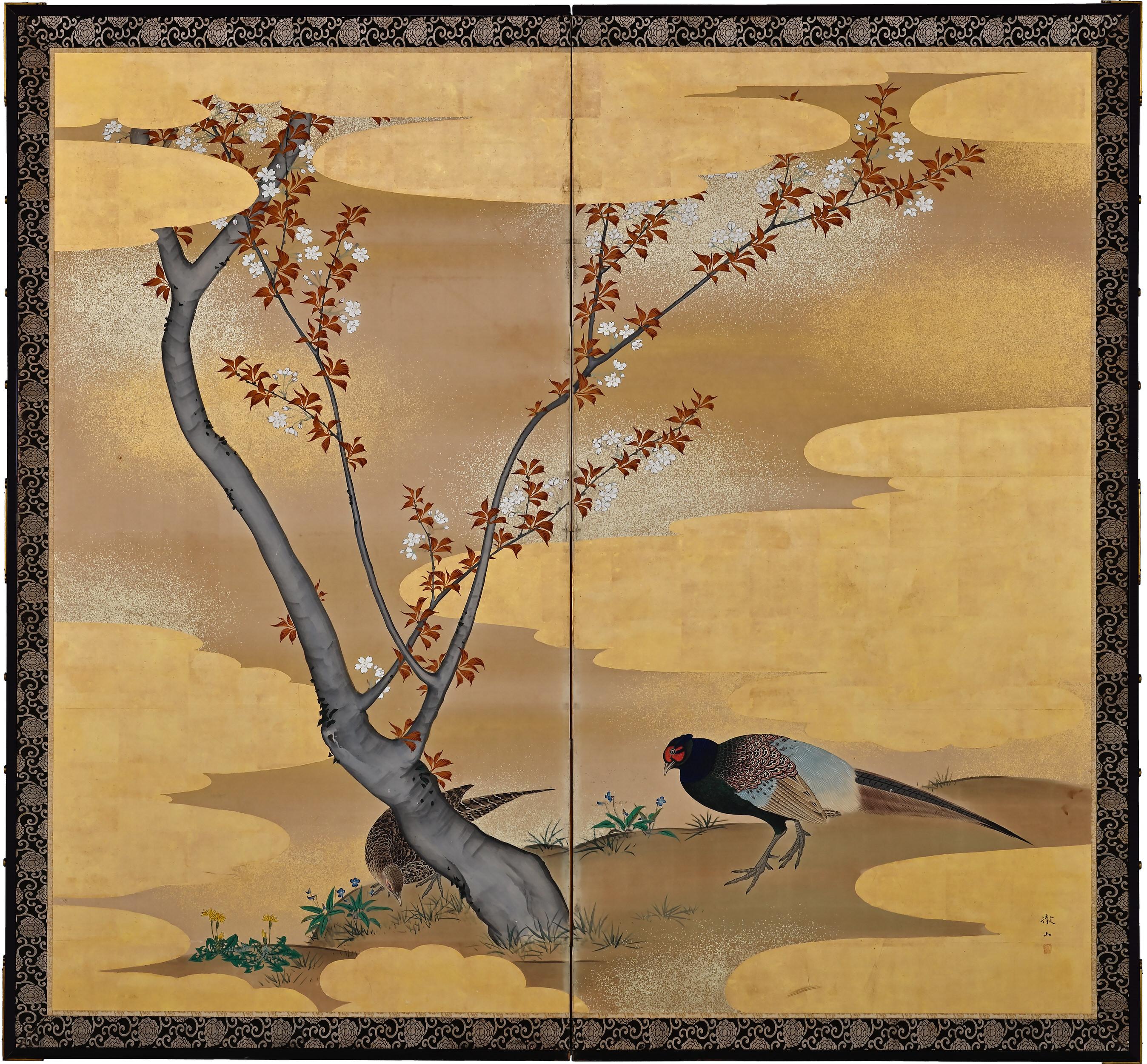Items Similar to Japanese Scroll Painting, 19th Century Chinese Pheasants by Yoshizawa Setsuan
Want more images or videos?
Request additional images or videos from the seller
1 of 6
Japanese Scroll Painting, 19th Century Chinese Pheasants by Yoshizawa Setsuan
About the Item
Chinese Pheasants
Yoshizawa Setsuan (1809-1889)
Hanging scroll, ink and color on silk.
Painting inscription: Setsuan Houyou
Upper seal: Yoshizawa
Lower seal: Ji Seryu
Dimensions:
Scroll 175 cm x 96 cm (69” x 38”)
Image 81 cm x 85 cm (32” x 33.5”)
A mid-19th century Japanese scroll painting depicting a pair of Chinese pheasants in a setting of blooming flowers. Presented as if the viewer were looking out a round window, the artist has created an intricate natural universe within the limited space of the painting surface. A richly colored work in saturated pigments, the composition is constructed of a number of complicated elements. The colors are used with exquisite taste, and to great decorative effect. The meticulous brushwork and the vocabulary of the birds and flowers has been passed down through the Buncho School of painting, and is an eclectic blend of the Chinese Nanpin school with Southern and Northern Song influences.
Yoshizawa Setsuan (1809-1889) was known as a talented painter in the bird-and-flower genre. He studied under Tosaka Bunyo (1783-1852), who was in turn a pupil of Tani Buncho (1763-1840).
- Dimensions:Height: 69 in (175.26 cm)Width: 38 in (96.52 cm)Depth: 1 in (2.54 cm)
- Style:Meiji (Of the Period)
- Materials and Techniques:
- Place of Origin:
- Period:
- Date of Manufacture:circa 1870
- Condition:The painting is recently re-mounted. There is light foxing present in the silk.
- Seller Location:Kyoto, JP
- Reference Number:1stDibs: LU2472318092852
About the Seller
5.0
Recognized Seller
These prestigious sellers are industry leaders and represent the highest echelon for item quality and design.
Gold Seller
These expertly vetted sellers are highly rated and consistently exceed customer expectations.
Established in 2001
1stDibs seller since 2016
60 sales on 1stDibs
Typical response time: 6 hours
- ShippingRetrieving quote...Ships From: Kyoto, Japan
- Return PolicyA return for this item may be initiated within 10 days of delivery.
More From This SellerView All
- 19th Century Japanese Shunga Hand-Scroll, Katsukawa SchoolLocated in Kyoto, JPShunga Unknown artist Meiji era, circa 1880 Hand-scroll mounted with 12 paintings Ink, pigment and gofun on silk Dimensions: Each image measures H. 23.2 cm x W. 34.4 cm (9.15” x 13.5”) The hand-scroll measures H. 28 cm x W. 540 cm (11” x 212”) A set of 12 late 19th century Japanese Shunga paintings mounted as a hand-scroll. Two of the leaves bear the signature and seal ‘Setsuzan’, although we are unable to confirm the identity of the artist using this art name. 6 of the 12 images are taken almost directly from Katsukawa Shuncho’s late 18th century woodblock series, ‘Erotic Pictures...Category
Antique Late 19th Century Japanese Meiji Paintings and Screens
MaterialsSilk
- 19th Century Japanese Scroll Painting by Igarashi Chikusa, Poppies & ButterfliesLocated in Kyoto, JPPoppies & Butterflies Ink, pigment and gofun on silk Igarashi Chikusa (1774-1844) Signature: Chikusa Ran Zen Upper Seal: Ran Shuzen Lower Seal: Kyoho Dimensions: Scroll: H. 68” x W. 18” (172cm x 45cm) Image: H. 38.5’’ x W. 12.5’’ (98cm x 32cm) This composition shows elegant images of poppies and the butterflies that are inevitably drawn to them. It captures a momentary glimpse into a world both visually dazzling and startlingly realistic. The painting is infused with sensitivity and attention to seasonal change and weather conditions. The thin and fragile poppies are beautifully depicted with brilliant colors and the butterflies are similarly infused with life. The painting is on silk which requires extremely precise painting skills as no element once painted can be removed. Poppies were a favorite subject of Rinpa school artists through the ages. Originally they were somewhat abstracted but by the age of Sakai Hoitsu...Category
Antique Early 19th Century Japanese Edo Paintings and Screens
MaterialsSilk
- Japanese Painting, Hanging Scroll, 19th Century Bamboo in MoonlightLocated in Kyoto, JPBamboo in moonlight Gamo Rakan (1784-1866) Hanging scroll, ink on silk. Dimensions: Scroll: 201 cm x 58 cm Image: 137 cm x 45 cm In this early 19th century work by Gamo Rakan a light ink wash applied to the silk background silhouettes the moon and suggests the atmosphere of early evening. Even though it is a literati subject, Rakan’s bamboo is quite realistic with a strong decorative style. The painting finds its inspiration from Chinese Ming dynasty painters who often used a single-tone, jet black stroke to emphasize the calligraphic nature of bamboo. In a different era, decorative would have been seen as somewhat unrefined. But increasingly in the Edo period, it was the hallmark of high style. The Japanese people, in particular the rising merchant class, had gradually become apathetic toward the traditional Sesshu and Kano schools of painting. Chinese professional and amateur painters living in the port of Nagasaki during the 18th century had a profound effect on Japanese painting and the freshness of their style and its decorative appeal contributed greatly to its popularity. Gamo Rakan’s teacher, Tani Buncho...Category
Antique Early 19th Century Japanese Edo Paintings and Screens
MaterialsSilk
- 19th Century Japanese Silk Painting by Kano Chikanobu, Pheasants & Plum in SnowLocated in Kyoto, JPBirds & Flowers of the Seasons Pheasants & Plum in Snow Ink, pigment and gofun on silk Kano Chikanobu 1819-1888 Signature: Chikanobu Seal: Shateki Offered here is an unframed ‘kacho-e’ painting by the 19th century Japanese Takamatsu domain painter Kano Chikanobu. There are 8 individual paintings available, which originally would have been part of a set of 12. ‘Kacho-e’ literally means ‘pictures of birds and flowers’. In reality it covers a wide range of natural motifs including birds, fish, insects and small animals in combination with flowers, grasses or trees. The theme has a long history in Japanese painting. It is one of three painting genres, the other two being landscape and figure, which derive from Chinese academic painting classification. As one of the accepted types of painting to be shown in official residences, scenes of birds, flowers and animals were rife with metaphorical reference as well as physical beauty. In these paintings Chikanobu has made conspicuous use of brilliant pigments and meticulous brushwork. The rocks, water, trees, blossoms, and birds are treated as stylized formal elements in a grand design. All of the components contribute to the patterned effect and tactile richness of the surface. Beyond their highly decorative qualities, the subject of some of the paintings are also an allusion to imperial allegiance; the pheasants are symbolic of bravery and steadfastness, peacocks represent divinity and power, and the phoenix paired with paulownia a just and benevolent ruler. Cranes and turtles symbolize longevity, and the lush, full bloom of the peony flower represents wealth and opulence. Paintings of native Japanese birds and flowers were appreciated primarily for their evocation of the seasons and the traditional poetic emotions associated with them. This is the case with the spring scene of cherry blossoms and birds and the winter scene of narcissus, nandina and sparrows. The rich expression of flower and bird paintings...Category
Antique Mid-19th Century Asian Edo Paintings and Screens
MaterialsSilk
- Early 19th Century Japanese Screen. Cherry Blossom & Pheasants by Mori TetsuzanLocated in Kyoto, JPMori Tetsuzan (1775-1841) Pheasants and Cherry Blossoms Two-fold Japanese screen. Ink, color, gofun, gold and silver on paper. A two-fold Japanese bir...Category
Antique Early 19th Century Japanese Edo Paintings and Screens
MaterialsGold Leaf
- 19th Century Japanese Scroll Painting, Birds & Flowers of the Four SeasonsLocated in Kyoto, JPBirds and flowers of the four seasons Early to mid-19th century Ink, pigment and gofun on silk Unidentified artist Signature: S...Category
Antique 1830s Japanese Edo Paintings and Screens
MaterialsSilk
You May Also Like
- Japanese Antique Ink Painting / 19th Century / Rare Chinese Character PaintingLocated in Sammu-shi, ChibaWe have a unique Japanese aesthetic sense. And only we can introduce unique items through our purchasing channels in Japan and the experience we have gained so far, in such a way that no one else can imitate. It is an ink painting written after the Meiji era. The biggest attraction of this work is that it uses Chinese characters to create paintings. To explain in detail, it is written here in Chinese characters as "un-ryu" . "Un" is a cloud and "ryu" is a dragon. These are embodied and drawn by comparing them to the meaning of Chinese characters. And the clouds depict the clouds hanging over the mountain, and the dragon depicts the climbing toward the mountain. Humorous paintings...Category
Antique Late 19th Century Japanese Edo Paintings
MaterialsAcrylic, Paper
- Large Framed Japanese Buddhist Amida Temple Hall Painting, Mid-19th CenturyLocated in Austin, TXA large and incredible Japanese painting of a Buddhist temple hall with Amida Nyorai, late Edo or early Meiji period, mid-19th century, Japan. Mounted wit...Category
Antique Mid-19th Century Japanese Meiji Paintings and Screens
MaterialsWood, Paint, Brocade, Silk, Acrylic
- Japanese Meiji Riverside Scroll Painting, c. 1900Located in Chicago, ILAlthough western painting was initially embraced during Japan’s Meiji period (1868-1912), artists brought on a revival of traditional painting styles as they sought to create a modern Japanese style with roots in the past. This exquisite hanging scroll demonstrates the preference for soft layering of gray tones with judicious use of color. The landscape is rendered in soft ink washes that subtly distinguish between water, mountain, and sky. The scroll painting...Category
Early 20th Century Japanese Meiji Paintings and Screens
MaterialsPaper
- Scroll Painting Japanese 19th-20th Century Kōgyō Terasaki MeijiLocated in Amsterdam, Noord HollandA fabulous landscape by Kogyo Terasaki 1866-1919 Japan painter. Akita prefecture production. Character is Tokusato, Soyama-Agaryunoki, beautiful poetry Yamabito, etc. to another is...Category
20th Century Japanese Meiji Paintings and Screens
MaterialsBronze
- 18th Century Japanese Scroll of PoppiesLocated in Hudson, NY18th century Japanese scroll of poppies. Edo Period (early 18th century) Japanese painting of poppies with lilies in the background. Seal on the lower...Category
Antique Early 18th Century Japanese Edo Paintings and Screens
MaterialsSilk, Paper
- Lovely Japanese 18th-19th Century Edo or Meiji Scroll Painting JapanLocated in Amsterdam, Noord HollandMaruyama–Shijo style painting C0ndition; Good but some stains. Overall dimensions: width of about 28.2 cm and Length of about 173.8 cm Painting width of about 25.5 cm × leng...Category
Antique 19th Century Japanese Meiji Paintings and Screens
MaterialsBronze
Recently Viewed
View AllMore Ways To Browse
19th Century Scroll
Hand Scrolls
Asian Influence Furniture
19th Century Painted Scroll
Japanese Painting 19th
Silk Scroll
19th Century Japanese Paintings
Round Window Used
19th Century Screens Asia
Antique Silk Painting
Antique Silk Paintings
Japanese Scroll
Japan Hand Painted China
Hanging Scrolls
Hanging Scroll
Hanging Screen
Asian Silk Art Painting
Asian Midcentury Artist





